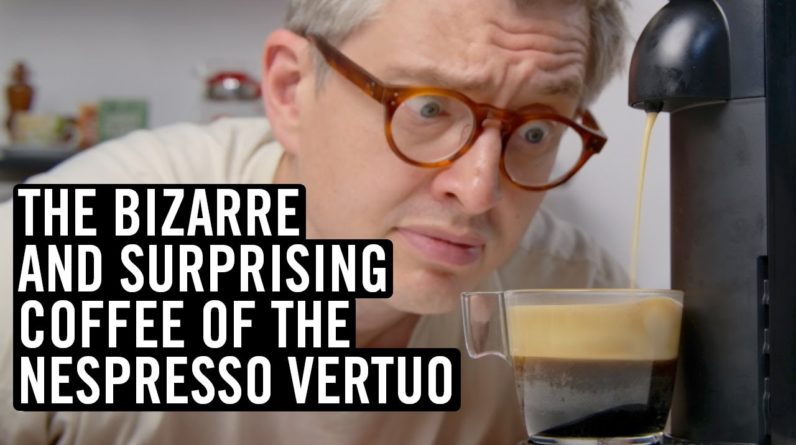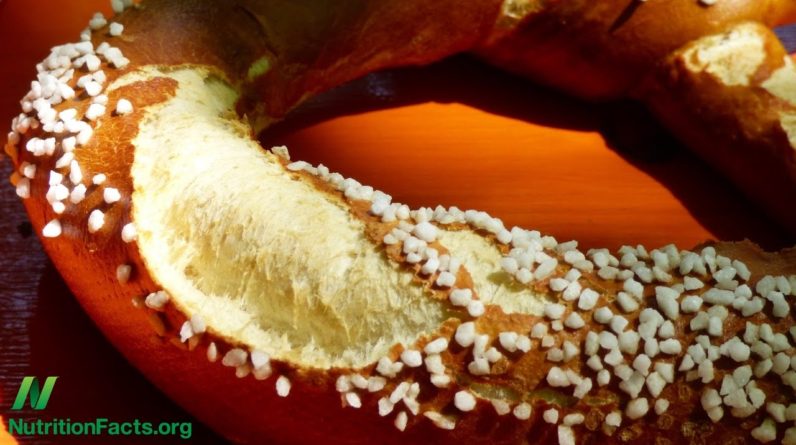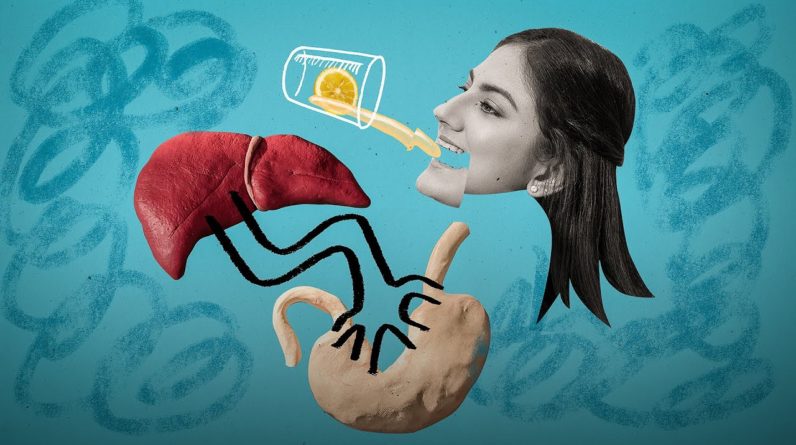
(machine whirs) (upbeat music) – Today, we're going to talk about this. It's the Nespresso Vertuo system, and it's ridiculous, gloriously
ridiculous in some ways, just bizarrely ridiculous in others, but I think it's interesting and definitely worth talking about. Now, if you're not familiar
with the Vertuo system, you are probably familiar with the classic Nespresso capsule system. You had these little things, five to six grams of coffee in them, and you could make a sort
of espresso thing with them, and they were, let's just say, popular. The world has changed and
they have their new thing. It came out 2014, but really
no one talks about it, and it's just so weird that I
kind of want to talk about it, and this is the system. So these pods are the Vertuo pods and they look quite
different to the old ones, and they come in three sizes of hump, I guess, three dome sizes.
You've got the little one, which is for an espresso type thing. You've got the medium hump
for, I suppose, a Lungo, and then I suppose most
interestingly to me, you've got this, a big
dome for a filter coffee. Now, I am dumb enough to go and read the patent for this thing and dig through the fairly
dense language, and within it, there's some interesting stuff, right? There's kind of the why
of this whole system. Now, before we get into the
sort of technical stuff, you should just see how this thing works, because you're going
to have some questions. (machine whirs) Completely unnecessary touch there. This goes in the middle here, and it drops into a little pod holder, and when you drop this down,
you'll hear it puncture.
Now, when I press go, it's going to do a bunch
of different stuff. Firstly, it's going to spin it around and read a barcode that is on
the underside of the capsule. Then it's going to pre-infuse
a little bit, right? And then it's going to spin the capsule at several thousand RPM while
pumping water through it, and what we get is kind of weird. (machine whirring) It keeps going. This is a lot to me. I suppose the audience
here is possibly divided. I don't find that appetizing, right? Like, I don't find that
weird layer of foam. I'm not going to call it crema because it seems to be
a whole other thing. I mean, look at the way it breaks down. It just gets weird and bubbly. If you read the patents, the kind of why of the system is that they wanted to be able to build a machine that made filter coffee with a thick layer of persistent crema that wasn't over-extracted, right? Then they would say, if you did this with an espresso machine, it would be over-extracted
and taste very bitter.
Our system allows you to
brew a big cup of coffee with a thick layer of coffee foam on top that isn't over-extracted. Now, you might well ask, why would you want a lot of coffee foam, a lot of crema-esque stuff,
on top of your drink? Nespresso have done research
in the past to do with how that layer of foam in their beverages elevates the sort of taste sensation from a tactile as well
as aromatic perspective. So maybe that's the kind of play here, but that is wild, right? Like, that is a very
weird drink to me to make, and that, it's lasting.
I think, in the patent, they said it would last
for at least 180 seconds to retain a certain percentage
of its original volume. Should we have a taste? Also in the patent is a
reference to the fact that, this system, it works much
better with dark roasts, and that is a darker roast. Right, like, that's much darker
than I would choose to drink, and it has this very intense bitterness. Would I say it tastes over-extracted? Honestly, probably, no, I wouldn't say it tastes over-extracted.
It just tastes of very
dark-roasted coffee, pretty well extracted. From that perspective, it's kind of a success,
but this whole thing, just watch the way when I open it up, it dispenses and gets
rid of the old capsule. It's just so much. Bye. It's just bizarre. Let me get the capsule out,
'cause that's also interesting. So, you can start to see
how the system is working. So this thing drops in and
it punctures it from above and it simultaneously punctures all the way around the edges. When you spin this, obviously, there'll be some compression
as the centrifugal forces kind of push the coffee outwards, and the theory here is
if you pump water in, it goes through this coffee and then out, and you have this very even extraction, because you've got all this
kind of centrifugal force pushing the coffee out the whole time. It does some weird stuff. If we just cut this open
and have a look inside, secondly, you can see this giant hole where the water would
have sort of gone in, and also the space that
would have been left by the centrifugal force.
Why? Why would you do this? Why is this the solution? And I suppose the answer
is a couple of things. Firstly, there is the thing
that they claim, right? Which is this is an
innovative way of brewing because you get this crema
on top on your big beverages and they don't taste over-extracted, and that's kind of an
interesting claim, right? And we can test that in a little bit and sort of play with
that a little bit more. Obviously, the second part
of this whole puzzle is that Nespresso have had a
taste of what it's like to have a defensible technology and to rule a marketplace,
to completely dominate. Let me just clean up a little bit. Let's talk about these again. Now, this was Nespresso's
beginnings, right? Their whole company began with
the kind of this thing here, the pod, but this pod does
not have their coffee inside. This has some delicious
specialty coffee inside. Now, how you feel about specialty pods, it's another video.
Go back to 2013, and there's a court case between Dualit in the UK and Nespresso, because Dualit were making
their own Nespresso pods, and you know, they make the machines too, but they were making
pods and Nespresso said, no, that's naughty. We've got the patent. You can't do it. And Dualit said, well, we think we can. We think that you don't
actually have protections around some of this stuff,
so we think we can make pods, and it went to court, and Dualit won.
Now, if you want a tiny
piece of coffee trivia, when Dualit went to court,
they brought an expert witness, a guy called Martin Nicholson. That name may be familiar to you, because he's the guy that
invented the Niche Zero Grinder. It's a small world. Back on topic, Nespresso no
longer dominate these things. You can get everything from
just nice washed coffee through to fancy, fancy,
natural process Geshas. The world of these little
pods has gone crazy. Now, Nespresso aren't really
trying to defend these the same way that they were back in 2013. They're still a bit defensive, but they're also kind of
pushing this much harder. Now, I should quickly mention, in the world of spinning coffee things, there is a machine
apparently called The Spinn. You might've seen it on
some bigger tech channels. It's popped up a couple of times.
They have offered me a unit, but because they've been on back order, they've been taking pre-orders for I think six or seven years
now without really shipping, I have said no to it, but it does look like
they're doing something a little bit similar with that. So maybe there is something in
this whole centrifugal thing. That is something I want to
look at a little bit more. If you go into the patents, Nestle say that they're actually brewing under relatively low
pressures inside there, and you can't really
convert centrifugal force to a pressure, to a brew pressure, right? Because brew pressure, well,
that requires a resistance.
You might have a force of
water hitting the coffee, but the pressure it builds
up is kind of to do with the resistance of the coffee. So it doesn't create a
fixed pressure necessarily, but it is still pushing
water through coffee in this weird and interesting way. What I want to do now just
quickly is show you one thing that I find super interesting. We're going to track the
flow of a brew, right? I'm going to brew another
of those big, long coffees onto a little Acaia scale. I'm gonna use the smart
espresso profiler app that will let me track the output flow. If you think about traditional espresso, your initial flow is quite slow, and then it picks up
speed towards the end, because you're eroding the coffee, right? You're destroying the resistance, and so if you're having
like a fixed force in, you'd have a faster flow out, and you'd also have a lower pressure, but we're getting off topic.
Let's brew a big cup of
coffee and see what happens. I'm going to show you the screenshot of the brew as it happens, 'cause it's interesting. (machine whirring) So we're holding really steady at like 2.6, 2.7 grams
a second, coming out. Like, really steady. We've crept up a little bit
to like 2.8, but really, it's sort of where it is. Barely any increase this entire brew. That's weird. Now, you heard it spin
up at the end there, I think to just dry out the capsule, to get as much liquid out as is possible. I mean, that is a weird brew. I've never seen anything like that in an espresso type system. We should see how an
espresso brews, actually. Let's check that. Now, that sounds like a much lower RPM, but the flow rate is
holding just really steady. (machines whirs) Now, that's interesting to me, because that is that kind of classic Nespresso profile of taste where they've got more
coffee in the capsule, so they're pulling a longer shot.
That's like 36 grams of espresso out, but from still a
relatively low coffee dose. In fact, let's just
quickly weigh that now. Let's weigh the three sized capsules and see what the difference is, see what the kind of
dose is for each of them. Show me your secrets. Now, this espresso is pretty fine. That is still a small pod. That is seven and a half
grams only in that capsule, which is more than a
traditional Nespresso capsule, but not by much. Now, for your Lungo, your 150 ml beverage, but you've got a bit more coffee. You're at 10 and a half
grams, 10.6 grams of coffee, and then again, it's pretty, pretty dark. And so to get a full
cup, to get a 230 ml cup, you know, I would be brewing, you'd be brewing 14 or 15 grams of coffee. What are they brewing? That's not ungenerous, but it's 13 grams, so 13 in 230 out, that's
obviously more liquid in, but you would, you know,
think about liquid out.

If we know the the weight of coffee in, and we know the weight of liquid out, and we've got a refractometer to measure the speed of
light through coffee, then we can know if their promise is true. How much of this are
they extracting, right? We can measure it. We can calculate it. We have the technology. Okay, so we've got 230 grams of beverage. We're going to push it
through a little filter to make sure there's no
undissolved material in the way. Now, I'm not going to lie.
This looks quite weak. Now, I was actually wrong on the strength. I was kind of thrown by it.
The strength is reasonable. It's about 1.3% coffee
in terms of the beverage. If you imagine like a beer is 4% alcohol, this is 1.3% coffee,
the rest is just water, and that means, you do the maths. The extraction's around 23%, right? Like, we can get into the
offsets for moisture and CO2. I don't want to do that. We can just say that's very extracted, not absurdly extracted,
but thoroughly extracted, and I wouldn't describe that as being over-extracted necessarily.
Now, the question that I have, really, is, how much of this is
just the coffee itself? It's very well-ground It's roasted in a certain way It's going to be soluble How much is the tech? How much is the machine?
How special is the machine? So, in just a minute, I'm
going to take on the machine. It's going to be man versus machine, and then also machine versus
machine, but before that is a short ad for this
video's sponsor, Surfshark.
Surfshark is a fast,
easy-to-use VPN service that is jam-packed full of features, and you can use it on unlimited devices. There's a few different
reasons to use a VPN. Obviously, one of them is
to add a layer of privacy to your online browsing,
but more than that, there's some pretty cool features. If you're traveling, it
lets you access features that you might otherwise not be able to. If you're in, say, China,
you can't access YouTube, but with a VPN, you could. Now, in fact, if you're just staying home, using a VPN lets you access geo-restricted services like Netflix. You can watch different country libraries, all from the comfort of your own home. Now, with a single subscription,
you can use Surfshark on an unlimited number
of different devices, and there are apps for all the platforms. Mac, PC, Linux, Android, iOS, you are covered and you can
use as many devices as you want at the same time. I have found the service to be super fast. There is live 24/7 customer support, and if you want to check it out, you can go to Surfshark.deal/JamesHoffmann and use coupon code JamesHoffmann for 83% off and three
extra months for free.
Check it out at the link below. Thank you to Surfshark
for sponsoring this video. So, here's how it's going to work. I've got 13 grams of coffee in here that I cut out of one of the capsules. I've got some water at about 85, a little bit lower, actually, because I checked the
outlet temperature here, and it was sort of 78, 79. I don't think they're losing much heat, and I think they do have
a patent for heating the kind of collection area
around the pod as well. So I think they're brewing low eighties. I'm going to try and brew
a V60 of this coffee, and then the machine
can brew, and we'll see, how much does the extraction vary? How much does the taste vary? How much is the technology doing? Looking at this, it's really
not blooming very much. There's very little CO2 in here, and the more I think about
it, the less I believe that the foam from this
machine is caused by CO2. It would seem possible,
perhaps even likely, that it's sort of foaming it with air rather than CO2 from the coffee.
Let's get this brewing. Hey! So we've got both our beverages. Now, I made this one with the V60. The machine made this one, obviously. They're the same recipes. Brew time's almost identical too. So, 13 in, a total of 230 grams out. We know this one is going
to be about 1.33% strength, because the other ones were. So, if we measure this, we'll know, have I done a comparable
job of extraction? Okay, so some big differences here. This one is 0.1% lower
in terms of strength. If you reverse the
calculation for extraction, that's about 2% less extraction. So, clearly the machine,
the spinny spinny, has given us a bump in extraction. Now, I'll taste them in a second. This is not really a
filtered beverage, right? Like, there's no paper filtration here. This is sort of bed filtration happening. It seems to be pretty effective, but I expect the texture
to be notably different to the paper-filtered coffee. Let's start with a benchmark. Quite a lot of texture, a ton of bitterness, no acidity, really. I wouldn't say much in
the way of sweetness in terms of what I think
coffee is capable of in terms of sweetness, but
the texture is quite nice.
I'll give it that. It's got some texture, but let's compare it to the V60. It's mostly worse, but in some
ways, a little bit better. It really misses that texture from both the additional strength, and also from being paper-filtered in comparison to not paper-filtered, and it felt like that texture was good because it sort of distracted
you from the bitterness that is kind of a little clearer here. That is actually less
bitter, more texture. One-nil to the machine. That's definitely a machine win. So, now, I want to go
machine versus machine, and for this, well, it
might be complicated, but I think it can be done. I'm going to program my
Decent to try and match the flow rate of these capsules. I'm going to program it to do a similar kind of pre-infusion,
which might be a mistake, but we'll see, and then
to try and hit that same 2.7, 2.8 grams of liquid a second, until we get to 230 grams of beverage, Let's see what happens.
So, here's the brew from the Decent. It was really interesting, quite easy to dial in, because
you can dial in by flow, and it turns out you
didn't need much pressure to have the kind of flow that we need through that compacted bed of coffee. I'm going to measure
the extraction of this while we brew a comparative
version on this.
We have an identical
strength, 1.33, once again. Same beverage mass out,
same dose of coffee in, very similar brew time, same
flow rates through this. This was pulling at like
half a bar, so in the patent, they talk about relatively low pressures. That does seem to be the case. How do they taste? Now, another advantage here in
the comparison for the Decent is that, like this,
it's not paper-filtered. It's, I suppose, metal-filtered. So you'd expect more texture,
more body from the Decent. Really interesting,
flavor, very comparable. I brewed the Decent at 82
Celsius through the whole shot, which I think is close to this. Flavor-wise, they're really similar, but obviously, the texture is different. This feels fluffier, unsurprisingly. That coffee foam is adding texture in a really interesting way. These were brewed identically. They were extracted identically. Why does this have all of this foam? What is this doing to make foam? I am more convinced than ever that this is aerated coffee foam, right? Like, if I get a blender
and I put this in a blender and I blend it, I'll get
some aerated coffee foam too.
I should get a blender. (blender whirs) Oh yeah, look at my crema. Not so special now, Nespresso. Look at it. I mean, this is not
necessarily an accusation, because clearly, like, it's
not like, "aha, I gotcha." Though, I gotcha, but I mean, look at it. The whole spinning thing is doing something like
this to the coffee, and does it change the texture? (James chuckles) Hmm, it does. It does. I would find these very
hard to tell apart now. The quality of foam as it breaks down doesn't look like crema
when it breaks down, but neither does this. In summary, I don't think
the Nespresso Vertuo system is doing anything particularly unusual in terms of extraction, right? Water is going through coffee
at a kind of flow rate, at a relatively low pressure, and it's extracting pretty well, and you can mimic that and
get very similar results at similar brew temperatures with similar flow rates and pressures.
That spinny system is hard to replicate. It's about locking you as a
consumer or a customer in. This whole technology is
around locking you in, not letting you buy
coffee from anywhere else, making sure that you're
spending your hundreds of pounds or dollars or euros or anything a year with them and no one else, and yeah, they're trying to offer
you an unusual beverage in terms of a foamy filter coffee, and it does taste pleasant,
but it's not special in terms of extraction. That coffee can be brewed other ways. You know, you can create a very
similar result quite easily. If you've got a stick blender at home, you're not far away
from the same experience if you want to know what fluffy, nice-tasting
filter coffee is like without having to use a system like this, but now I want to hear from you.
Have you tried this? Do
you have one of these? What do you think? Do you like a big, foamy,
foamy kind of filter coffee? Does that please you?
Do you like the texture? Have you enjoyed that? Do you like the coffee, or do
you just like the convenience? I really want to hear from you
down in the comments below. I think this was originally just available in the US when it launched, but
I think it is now worldwide, so hopefully some of you have
the chance to experience this, and I know we didn't get into the whole "Nestle is evil" thing, and I'm not going to defend
them for the indefensible things they've said and done, but I just wanted to talk
about coffee brewing tech, because I think it's interesting.
For now, I'll say thank
you so much for watching, and I hope you have a great day..







